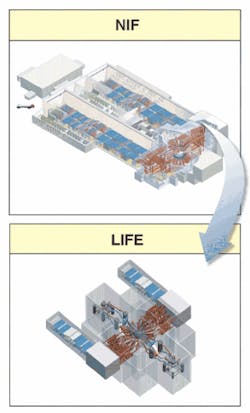
The goal of the U.S. National Ignition Facility (NIF; lasers.llnl.gov) at Lawrence Livermore National Laboratory (LLNL; Livermore, CA), due for completion in March 2009, the Laser MegaJoule (LMJ; Bordeaux, France), and the European High-Power Laser for Energy Research (HiPER) programs is to achieve laser fusion: the process of releasing more energy from a capsule of fusion fuel than is required to initiate the reaction by the high-power “ignition” laser source. Unlike the ITER (www.iter.org) project, which uses magnetic confinement to create a sustained fusion reaction, the laser inertial-confinement method used for NIF, LMJ, and HiPER uses lasers to implode a capsule of hydrogen fuel to extreme pressures and temperatures to achieve thermonuclear ignition and burn. A fusion reaction creates much less waste than a conventional fission-based nuclear reactor, with a radioactivity level well below the nuclear waste from fission reactors.
In his plenary presentation at the International Congress on the Applications of Lasers & Electro-Optics (ICALEO 2008; Temecula, CA, Oct. 22, 2008), LLNL chief research and development officer Tomás Diaz de la Rubia expressed his confidence that NIF will meet its goals of achieving a credible attempt at ignition in 2010 and becoming a highly flexible high-energy-density science user facility by 2012. He was equally enthusiastic about a new Laser Inertial-Confinement Fusion-Fission Energy (LIFE) approach for sustainable, carbon-free energy.1
With fossil-fuel power plants around the world releasing 27 to 28 gigatons of carbon dioxide each year into the atmosphere, Diaz de la Rubia is convinced that new sources of energy are imperative for the planet’s future. And because nuclear reactors only consume 0.5% of their fuel, with the remainder either reprocessed and recycled or temporarily stored in ponds at reactor sites until long-term storage in underground repositories is available, these new processes must be efficient and environmentally friendly. In fact, if only conventional once-through open-cycle nuclear reactors are constructed, the equivalent of 16 Yucca Mountain waste repositories will be needed by the year 2100.
Eliminating dangerous nuclear waste
The exciting concept of the LIFE project is that it combines both fusion and fission–a “hybrid” approach promoted by LLNL as the best means to efficiently produce clean energy. Essentially, laser-driven fusion targets are surrounded by a fission blanket that contains spent nuclear fuel, natural or depleted uranium, or weapons-grade plutonium. The fusion reaction initiates a fission reaction that burns nearly 100% of the fission fuel from this nuclear waste, creating thermal energy that can be converted to electricity by steam turbines. Not only would the reaction consume the available stockpiles of dangerous spent nuclear fuel, but no refueling would be necessary for 50 years.
The fusion portion of LIFE is based on the physics and technology developed for the NIF project: 192 laser beams from frequency-tripled neodymium lasers produce 1.8 MJ of 351 nm energy in 20 ns pulses that irradiate a deuterium/tritium fuel capsule, releasing neutrons and alpha particles and generating intense heat.
NIF, however, will execute one laser shot every few hours. A LIFE engine needs to execute on the order of 10 shots per second. This high repetition rate calls for diode-pumped solid-state (DPSS) lasers rather than the flashlamp-driven lasers used in NIF. The LIFE power plant system comprises a 10 to 15 Hz DPSS laser with a wall-plug efficiency of approximately 10%, a fusion-target factory, a fusion-target chamber surrounded by a subcritical fission blanket, and the balance of the plant.
In a LIFE engine, the point source of fusion neutrons acts as a catalyst to drive the fission blanket, which obviates the need for a critical assembly to sustain the fission chain reaction. Starting from as little as 300 to 500 MW of fusion power, a single LIFE engine can generate 2000 to 3000 megawatts thermal (MWt) in steady state for periods of years to decades, depending on the nuclear fuel and engine configuration. The source of “external neutrons” drives the sub-critical-fission blanket and makes the LIFE engine capable of burning any fertile or fissile nuclear material, including depleted uranium and spent nuclear fuel.
The LIFE engine is not without its challenges, however. In order for the LIFE project to manifest itself as a demonstration power plant by the year 2020, the price of fusion targets must be decreased, new long-lived materials must be developed, and low-cost DPSS lasers are needed to reduce the cost of the laser source itself.
“Experts predict that the cost of diodes used in DPSS lasers will continue to decrease significantly over the next several years,” says Diaz de la Rubia. “Building on the anticipated success of NIF, LIFE engines offer a pathway toward sustainable and safe nuclear power that significantly mitigates nuclear-proliferation concerns and minimizes nuclear waste.”
REFERENCE
- T. Diaz de la Rubia and E.I. Moses, ICALEO 2008 Plenary presentation, Temecula, CA (Oct. 20, 2008).
About the Author

Gail Overton
Senior Editor (2004-2020)
Gail has more than 30 years of engineering, marketing, product management, and editorial experience in the photonics and optical communications industry. Before joining the staff at Laser Focus World in 2004, she held many product management and product marketing roles in the fiber-optics industry, most notably at Hughes (El Segundo, CA), GTE Labs (Waltham, MA), Corning (Corning, NY), Photon Kinetics (Beaverton, OR), and Newport Corporation (Irvine, CA). During her marketing career, Gail published articles in WDM Solutions and Sensors magazine and traveled internationally to conduct product and sales training. Gail received her BS degree in physics, with an emphasis in optics, from San Diego State University in San Diego, CA in May 1986.